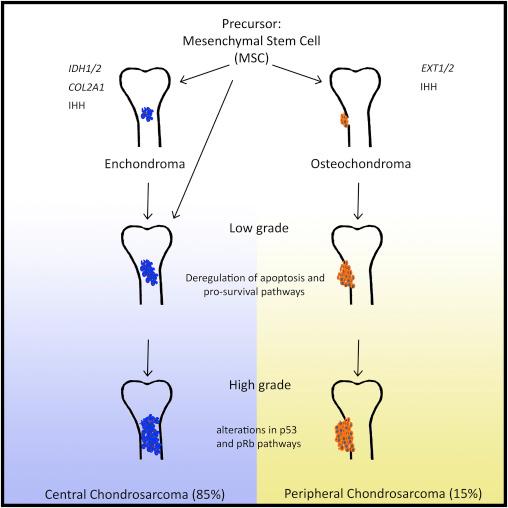Physical Address
304 North Cardinal St.
Dorchester Center, MA 02124
© 2018 Elsevier Inc. All rights reserved. Please note that the copyright for the original figures submitted by the contributors is owned by Contributors.
Chondrosarcoma is a malignant cartilage-forming tumor accounting for 20% of all malignant bone tumors. Only a small percentage of chondrosarcomas is found in the skull or spine (2%–12%). Depending on the subtype, different molecular pathways are involved in development and progression of chondrosarcoma. In the skull or spine, chondrosarcoma needs to be distinguished from chordoma, which shows a similar presentation and anatomical location, but a different biological behavior. The distinction can be made using brachyury immunohistochemistry, as overexpression of brachyury is the hallmark of chordoma. On the other hand, chondrosarcomas represent a heterogeneous group of tumors, in which different cell signaling pathways are involved in tumorigenesis. In this chapter, the most important pathways will be discussed.
Chondrosarcomas can be divided in conventional chondrosarcoma (85%) and more rare subtypes; dedifferentiated chondrosarcoma (10%), mesenchymal chondrosarcoma (2%), clear-cell chondrosarcoma (2%), and periosteal chondrosarcoma (1%). Central conventional chondrosarcoma is the most common in the skull and spine, followed by mesenchymal chondrosarcoma.
Conventional chondrosarcoma can be further subdivided into central (>85%) and peripheral chondrosarcomas (∼15%) based on its location in the bone. Central chondrosarcomas develop in the bone either directly or from a benign enchondroma (see Fig. 4.1 ).

Enchondromas can develop as a solitary lesion or as multiple enchondromas in Ollier disease or Maffuci syndrome. Ollier disease and Maffuci syndrome are both rare, nonhereditary disorders caused by somatic mosaic mutations in IDH1 or IDH2 . Among solitary enchondromas ∼1% undergoes malignant transformation toward a conventional central chondrosarcoma. Enchondromas from patients with multiple enchondromas have a much higher transformation rate of ∼50%.
Peripheral chondrosarcomas develop at the surface of the bone from a preexisting benign osteochondroma. They develop from bones that are formed by endochondral ossification; consequently, they are extremely rare in the skull. Central and peripheral chondrosarcomas show similar histological features and are graded using a three-tiered scale. Atypical cartilaginous tumors (previously chondrosarcoma grade-I) show low cellularity and do not metastasize, but are locally aggressive, and local recurrences can develop. Grade-II and -III chondrosarcomas are high-grade tumors with increased cellularity and mitoses. These tumors show a higher metastatic rate and poor patient survival. Patients with atypical cartilage tumors show a 10-year overall survival rate of 83%, while patients with grade-II chondrosarcomas show a 10-year survival rate of 64% and patients with a grade-III chondrosarcoma show the poorest 10-year survival rate of 29%. So far, histological grade is the most important predictor of prognosis. Upon recurrence of low-grade tumors, progression toward a higher histological grade can occur in ∼13% of the cases, resulting in a poorer prognosis. Chondrosarcomas are resistant to conventional chemo- and radiotherapy, leaving surgical removal as the only treatment option. This has major implications for patients with inoperable disease for whom no good treatment option exists.
Dedifferentiated chondrosarcoma comprises ∼10% of all chondrosarcomas. It is a high-grade chondrosarcoma variant characterized by a mixed histological appearance of dedifferentiated cells and a cartilaginous component. Patients with dedifferentiated chondrosarcoma show a 5-year overall survival between 7% and 24%. Like conventional chondrosarcoma, dedifferentiated chondrosarcoma is resistant to conventional chemo- and radiotherapy. Mesenchymal chondrosarcoma is a rare high-grade chondrosarcoma consisting of differentiated cartilage mixed with undifferentiated small round cells. The 10-year survival rate ranges between 27% and 67%. The small, round cell component of mesenchymal chondrosarcoma may respond better to chemotherapy than do other chondrosarcoma subtypes. Clear-cell chondrosarcoma is a rare low-grade chondrosarcoma mainly found in the epiphysis of the humoral or femoral head. Histologically, clear-cell chondrosarcoma shows malignant cells with clear, empty cytoplasm surrounded by hyaline cartilaginous matrix. Surgery is the only treatment option for patients with clear-cell chondrosarcoma. The prognosis is relatively good, with a mortality rate of 15%. Periosteal chondrosarcoma is the rarest chondrosarcoma subtype; it accounts for less than 1% of the cases and originates from the periosteum.
This chapter discusses the mutations and deregulated pathways identified in the different chondrosarcoma subtypes. It will focus on central conventional chondrosarcoma, the most extensively studied subtype. Mutations in IDH1 and IDH2 occur in central as well as dedifferentiated and periosteal chondrosarcoma. COL2A1 mutations and alterations in Indian hedgehog genes are seen in a small percentage of central chondrosarcoma. Deregulation of the hedgehog pathway occurs on most chondrosarcomas, indicating its importance to the development of these tumors. Peripheral chondrosarcomas are characterized by mutations in EXT1 or EXT2 . Both central and peripheral chondrosarcomas show alterations in p53 and pRb pathways when progressing from low to high grade.
Become a Clinical Tree membership for Full access and enjoy Unlimited articles
If you are a member. Log in here